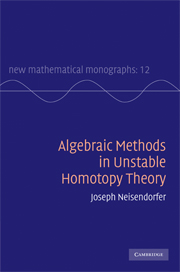Book contents
- Frontmatter
- Contents
- Preface
- Acknowledgments
- Introduction to unstable homotopy theory
- 1 Homotopy groups with coefficients
- 2 A general theory of localization
- 3 Fibre extensions of squares and the Peterson–Stein formula
- 4 Hilton–Hopf invariants and the EHP sequence
- 5 James–Hopf invariants and Toda–Hopf invariants
- 6 Samelson products
- 7 Bockstein spectral sequences
- 8 Lie algebras and universal enveloping algebras
- 9 Applications of graded Lie algebras
- 10 Differential homological algebra
- 11 Odd primary exponent theorems
- 12 Differential homological algebra of classifying spaces
- Bibliography
- Index
12 - Differential homological algebra of classifying spaces
Published online by Cambridge University Press: 03 May 2010
- Frontmatter
- Contents
- Preface
- Acknowledgments
- Introduction to unstable homotopy theory
- 1 Homotopy groups with coefficients
- 2 A general theory of localization
- 3 Fibre extensions of squares and the Peterson–Stein formula
- 4 Hilton–Hopf invariants and the EHP sequence
- 5 James–Hopf invariants and Toda–Hopf invariants
- 6 Samelson products
- 7 Bockstein spectral sequences
- 8 Lie algebras and universal enveloping algebras
- 9 Applications of graded Lie algebras
- 10 Differential homological algebra
- 11 Odd primary exponent theorems
- 12 Differential homological algebra of classifying spaces
- Bibliography
- Index
Summary
This chapter completes the presentation of differential homological algebra which was started in Chapter 10. Following the presentation of Moore in the Cartan seminar, we show how the homology of a topological group determines the homology of its classifying space. This leads to the first quadrant Eilenberg–Moore spectral sequence which has also gone by a variety of other names, for example, the Milnor–Moore spectral sequence or the Rothenberg–Steenrod spectral sequence.
We try to emphasize the fact that the spectral sequence is a secondary object which comes from a chain model of the classifying space. Unfortunately, this approach is not as successful here as it was with the applications in Chapter 11 of the second quadrant Eilenberg–Moore spectral sequence. For example, the Borel transgression theorem requires the use of the spectral sequence.
The algebra of this first quadrant Eilenberg–Moore spectral sequence is based on the fact that the normalized chains of a topological group form a differential Hopf algebra. The second quadrant Eilenberg–Moore spectral sequence was based on the fact that the normalized chains on a topological space form an associative differential coalgebra.
In the case of the second quadrant Eilenberg–Moore models, the dominant algebraic structure is the structure of an associative algebra in differential Cotor. In the case of the first quadrant Eilenberg–Moore models to be studied here, the dominant algebraic structure is that of an associative coalgebra in differential Tor.
- Type
- Chapter
- Information
- Algebraic Methods in Unstable Homotopy Theory , pp. 489 - 544Publisher: Cambridge University PressPrint publication year: 2010

